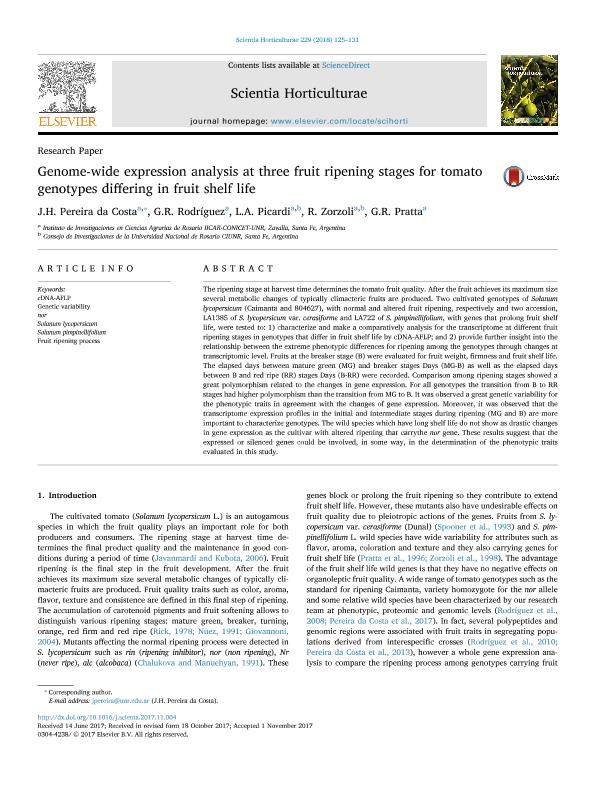Mostrar el registro sencillo del ítem
dc.contributor.author
Pereira Da Costa, Javier Hernán

dc.contributor.author
Rodríguez, Gustavo Rubén

dc.contributor.author
Picardi, Liliana Amelia

dc.contributor.author
Zorzoli, Roxana

dc.contributor.author
Pratta, Guillermo Raúl

dc.date.available
2019-11-28T22:29:42Z
dc.date.issued
2018-02
dc.identifier.citation
Pereira Da Costa, Javier Hernán; Rodríguez, Gustavo Rubén; Picardi, Liliana Amelia; Zorzoli, Roxana; Pratta, Guillermo Raúl; Genome-wide expression analysis at three fruit ripening stages for tomato genotypes differing in fruit shelf life; Elsevier Science; Scientia Horticulturae; 229; 2-2018; 125-131
dc.identifier.issn
0304-4238
dc.identifier.uri
http://hdl.handle.net/11336/90859
dc.description.abstract
The ripening stage at harvest time determines the tomato fruit quality. After the fruit achieves its maximum size several metabolic changes of typically climacteric fruits are produced. Two cultivated genotypes of Solanum lycopersicum (Caimanta and 804627), with normal and altered fruit ripening, respectively and two accession, LA1385 of S. lycopersicum var. cerasiforme and LA722 of S. pimpinellifolium, with genes that prolong fruit shelf life, were tested to: 1) characterize and make a comparatively analysis for the transcriptome at different fruit ripening stages in genotypes that differ in fruit shelf life by cDNA-AFLP; and 2) provide further insight into the relationship between the extreme phenotypic differences for ripening among the genotypes through changes at transcriptomic level. Fruits at the breaker stage (B) were evaluated for fruit weight, firmness and fruit shelf life. The elapsed days between mature green (MG) and breaker stages Days (MG-B) as well as the elapsed days between B and red ripe (RR) stages Days (B-RR) were recorded. Comparison among ripening stages showed a great polymorphism related to the changes in gene expression. For all genotypes the transition from B to RR stages had higher polymorphism than the transition from MG to B. It was observed a great genetic variability for the phenotypic traits in agreement with the changes of gene expression. Moreover, it was observed that the transcriptome expression profiles in the initial and intermediate stages during ripening (MG and B) are more important to characterize genotypes. The wild species which have long shelf life do not show as drastic changes in gene expression as the cultivar with altered ripening that carrythe nor gene. These results suggest that the expressed or silenced genes could be involved, in some way, in the determination of the phenotypic traits evaluated in this study.
dc.format
application/pdf
dc.language.iso
eng
dc.publisher
Elsevier Science

dc.rights
info:eu-repo/semantics/openAccess
dc.rights.uri
https://creativecommons.org/licenses/by-nc-nd/2.5/ar/
dc.subject
CDNA-AFLP
dc.subject
FRUIT RIPENING PROCESS
dc.subject
GENETIC VARIABILITY
dc.subject
NOR
dc.subject
SOLANUM LYCOPERSICUM
dc.subject
SOLANUM PIMPINELLIFOLIUM
dc.subject.classification
Horticultura, Viticultura

dc.subject.classification
Agricultura, Silvicultura y Pesca

dc.subject.classification
CIENCIAS AGRÍCOLAS

dc.title
Genome-wide expression analysis at three fruit ripening stages for tomato genotypes differing in fruit shelf life
dc.type
info:eu-repo/semantics/article
dc.type
info:ar-repo/semantics/artículo
dc.type
info:eu-repo/semantics/publishedVersion
dc.date.updated
2019-10-23T20:48:06Z
dc.journal.volume
229
dc.journal.pagination
125-131
dc.journal.pais
Países Bajos

dc.journal.ciudad
Amsterdam
dc.description.fil
Fil: Pereira Da Costa, Javier Hernán. Consejo Nacional de Investigaciones Científicas y Técnicas. Centro Científico Tecnológico Conicet - Rosario. Instituto de Investigaciones en Ciencias Agrarias de Rosario. Universidad Nacional de Rosario. Facultad de Ciencias Agrarias. Instituto de Investigaciones en Ciencias Agrarias de Rosario; Argentina
dc.description.fil
Fil: Rodríguez, Gustavo Rubén. Consejo Nacional de Investigaciones Científicas y Técnicas. Centro Científico Tecnológico Conicet - Rosario. Instituto de Investigaciones en Ciencias Agrarias de Rosario. Universidad Nacional de Rosario. Facultad de Ciencias Agrarias. Instituto de Investigaciones en Ciencias Agrarias de Rosario; Argentina
dc.description.fil
Fil: Picardi, Liliana Amelia. Consejo Nacional de Investigaciones Científicas y Técnicas. Centro Científico Tecnológico Conicet - Rosario. Instituto de Investigaciones en Ciencias Agrarias de Rosario. Universidad Nacional de Rosario. Facultad de Ciencias Agrarias. Instituto de Investigaciones en Ciencias Agrarias de Rosario; Argentina
dc.description.fil
Fil: Zorzoli, Roxana. Consejo Nacional de Investigaciones Científicas y Técnicas. Centro Científico Tecnológico Conicet - Rosario. Instituto de Investigaciones en Ciencias Agrarias de Rosario. Universidad Nacional de Rosario. Facultad de Ciencias Agrarias. Instituto de Investigaciones en Ciencias Agrarias de Rosario; Argentina
dc.description.fil
Fil: Pratta, Guillermo Raúl. Consejo Nacional de Investigaciones Científicas y Técnicas. Centro Científico Tecnológico Conicet - Rosario. Instituto de Investigaciones en Ciencias Agrarias de Rosario. Universidad Nacional de Rosario. Facultad de Ciencias Agrarias. Instituto de Investigaciones en Ciencias Agrarias de Rosario; Argentina
dc.journal.title
Scientia Horticulturae

dc.relation.alternativeid
info:eu-repo/semantics/altIdentifier/doi/http://dx.doi.org/10.1016/j.scienta.2017.11.004
Archivos asociados
